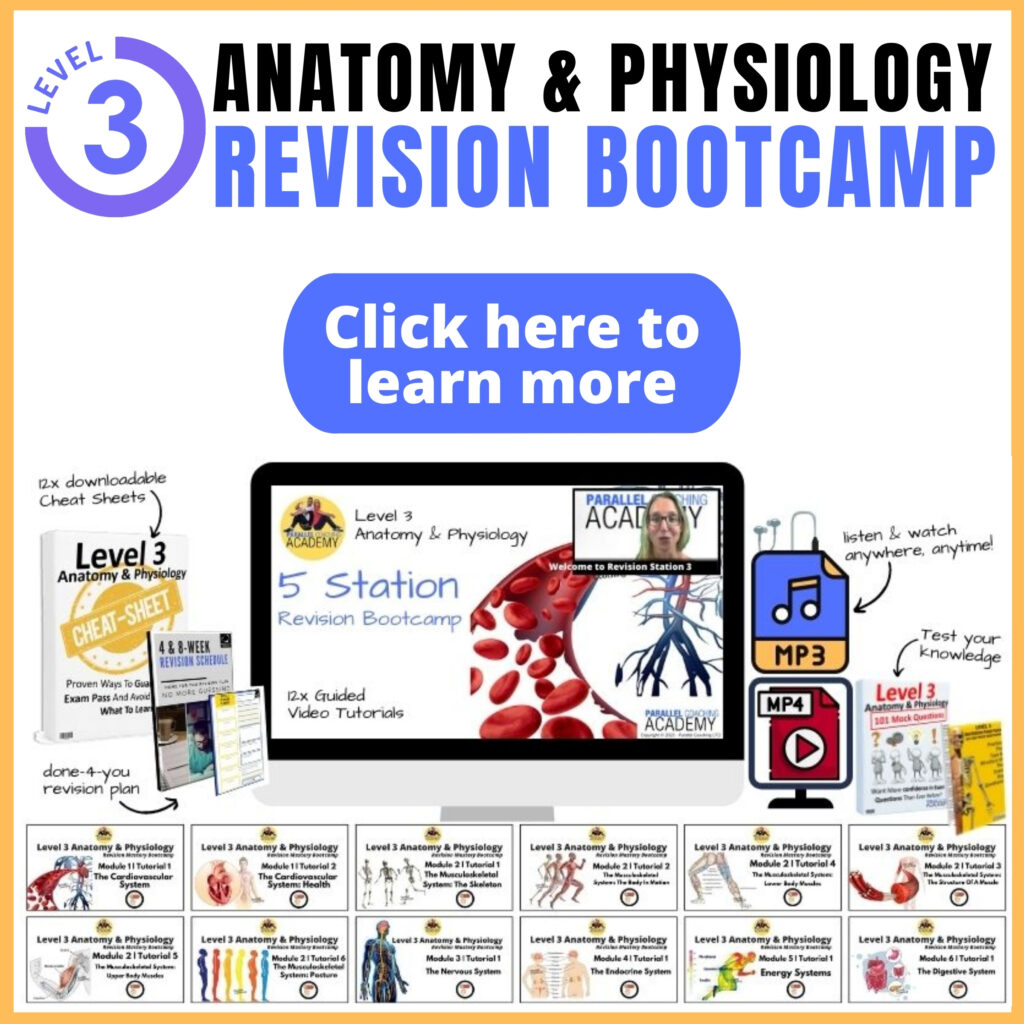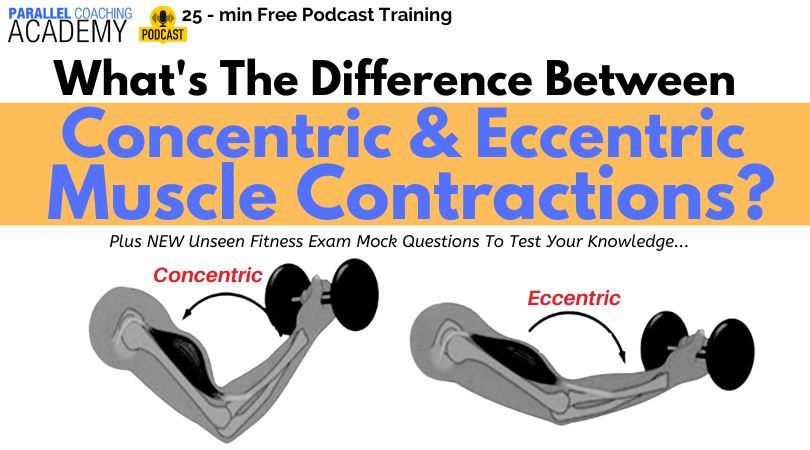Welcome to today’s blog, where we’re diving deep into concentric and eccentric contractions, in the world of anatomy and physiology!
Today, we’re unravelling the mystery surrounding concentric and eccentric muscle contractions. If you’ve ever found yourself confused about these terms, you’re not alone.
But fear not, because we’re here to make this tricky topic simple and accessible.
Understanding the different types of muscle contractions is essential for anyone in the fitness industry, whether you’re a personal trainer, fitness professional, or simply a fitness enthusiast looking to deepen your knowledge.
Let’s get started on demystifying concentric and eccentric contractions!
To complement your learning journey, we’ve also prepared an exciting resource for you.
Our 25-minute FITPRO Sessions podcast episode dives even further into this topic, providing valuable insights and expert perspectives.
Tune in to gain a comprehensive understanding of concentric and eccentric contractions and how they relate to your fitness goals.
But wait, there’s more! We know that testing your knowledge is crucial for mastering any subject. That’s why we’ve included three exam mock questions in this blog to challenge your understanding of concentric and eccentric contractions.
Test your knowledge and see how well you grasp the concepts.
Additionally, if you’re currently preparing for an upcoming exam or want to ace your revision prep, we’re thrilled to offer you an opportunity to join our Revision Bootcamps.
Our revision bootcamps are specifically designed for FITPROs like you, aiming to pass your anatomy and physiology exam with ease.
Don’t let overwhelming revision sessions hold you back—let us guide you through a streamlined, efficient study plan.
So, whether you’re looking to enhance your understanding of muscle contractions, explore our insightful podcast episode, test your knowledge with mock questions, or join our Revision Bootcamps, this blog is your go-to resource.
Let’s unravel the complexities of concentric and eccentric muscle contractions together, simplifying the topic and empowering you with knowledge.
Stay tuned for the upcoming sections, where we’ll break down the concepts, provide practical examples, and shed light on their significance in fitness and exercise.
Remember, the journey of learning never ends, and we’re excited to be part of your educational experience.
Let’s embark on this enlightening exploration of concentric and eccentric muscle contractions!
Continue reading, listening, and mastering this topic to elevate your fitness expertise and excel in your career.
Listen and Learn
FITPRO SESSIONS PODCAST
Season 11: Episode 9 = 24 mins of learning
What’s The Difference Between Concentric and Eccentric Contractions
Click the link below to Download from your favourite Podcast App:
Spotify: https://open.spotify.com/show/0p0OPNC2SqSrGOz7H7Z8YU
iTunes: https://podcasts.apple.com/…/fitpro-sessions/id1485703708
Two meanings one phrase
The phrase “concentric and eccentric” is used in different ways:
- It relates to the concentric and eccentric muscle contractions
- It relates to the lifting or lowering phase of a movement
Let’s look into these in more detail…
Concentric and eccentric muscle contractions
This would appear in your exam like this:
“What happens to a muscle during concentric contraction”
The question is asking about concentric muscle contraction rather than phases of movement. To answer this question you need to know what happens during a concentric and eccentric contraction, and how these differ.
First of all, make sure you’ve learned about how a muscle contracts. You’ll need to understand the sliding filament theory and that a muscle contracts by getting shorter and longer along its length. When skeletal muscle contracts the origin and insertion of the muscle get closer together, which pulls on the tendon, and then on the bone. This then creates action at the joint.
A Concentric Muscle Contraction = When the muscle contracts and shortens
For example, if the Biceps Brachii contracts Concentrically, the muscle shortens and two attachment points go towards each other, creating flexion at the elbow.
An Eccentric Muscle Contraction = When the muscle contracts and lengthens or elongates
For example, if the Biceps Brachii contracts Eccentrically, the muscle lengthens and the two attachment points move apart from each other, creating extension at the elbow.
so in answer to the question:
“What happens to a muscle during concentric contraction”
You would expect the answer to be “the muscle shortens”
Now let’s take a look at the other use of the term “concentric and eccentric”
The lifting or lowering phase of a movement
Every movement and exercise has a lifting and a lowering phase.
For example, the squat has the lowering phase when you move from standing and lower down into tripled flexed position at the bottom of the movement.
The lifting phase is then lifting from this position, against the force of gravity, to standing again.
The Concentric Phase of a Movement = The Lifting Phase, whereby the load goes towards the Clouds against gravity (c for concentric, c for clouds). Note, the load is your own body weight in a press-up, or the dumbbell in a bicep curl, or the weight stack on a Lat Pull Down machine.
The Eccentric Phase of a Movement = The Lowering Phase, whereby the load goes towards the Earth with gravity (e for eccentric, e for earth). Note, this phase feels easier, because we are no longer pushing the load against the force of gravity, instead gravity is helping the lowering phase.
A common question in your exam would be…
“What joint action occurs at the hip during the Eccentric Phase of a squat”
so, let’s break it down…
- The eccentric phase of the squat is the lowering phase, going from standing to a tripled-flexed position
- The question is asking what happens at the hip during this phase
- When we are standing our hips are extended, when we squat down, the hip flexes
- So the hip moves through flexion and extension in the sagittal plane.
- Concentric phase = extension of the hip which is powered by the gluteus maximus concentrically contracting
- Eccentric phase = flexion of the hip which occurs because the gluteus maximus is eccentrically contracting
so the answer would be “Flexion at the Hip”
Before I share a few mock questions with you to practice on, here are some exam-day tips:
Tips to Correctly answer concentric vs Eccentric questions
- READ the question
Now you know there are two uses of the phrase “concentric and eccentric” you need to READ the question carefully, to decipher what the question is asking you - LINK the keyword
remind yourself of the difference between the phase of movement and muscle contraction. Then recall the difference between concentric and eccentric - RE-READ the question
Now you have the context, re-read the question and answer it.
Test your knowledge with today’s Concentric and Eccentric mock questions:
[NOTE: The answers are below the 3rd question]
Q1: Which of the following best describes a concentric muscle contraction?
a) Muscle lengthening while generating force
b) Muscle shortening while generating force
c) Muscle lengthening while resisting force
d) Muscle shortening while resisting force
Q2: What is the primary function of eccentric muscle contractions?
a) Generating power and performing dynamic movements
b) Controlling movements and decelerating forces
c) Increasing muscle flexibility and range of motion
d) Building muscle endurance and cardiovascular fitness
Q3: Which of the following statements is true regarding concentric and eccentric contractions?
a) Eccentric contractions produce higher levels of force compared to concentric contractions.
b) Concentric contractions are more taxing on the muscles and contribute to delayed onset muscle soreness (DOMS).
c) Eccentric contractions involve muscle shortening and force generation.
d) Concentric and eccentric contractions have the same impact on muscle strength and development.
Answers to the mock questions are :
Question 1= B, Question 2 = B, Question 3 = B
If you want more mock questions like this, then you can download more Free Mock Questions: DOWNLOAD NOW
 Calling all Trainee FITPROs!
Calling all Trainee FITPROs! 
Are you preparing for your Anatomy & Physiology exam and feeling overwhelmed by the sheer amount of information?
Don’t worry, we’ve got you covered! Introducing our exclusive Revision Bootcamps designed specifically for Trainee FITPROs like you.
Join our Revision Bootcamps and discover a streamlined approach to learning, revising, and passing your Anatomy & Physiology exam in under 10 hours!
Say goodbye to endless hours of studying and hello to effective, efficient revision.
What’s included in our Revision Bootcamps?
- Revision Station 1: Clear Revision Strategies – Get clarity on how to revise effectively, so you can optimize your study time and focus on what truly matters.
- Revision Station 2: Customized Revision Plans – Receive a 4-week and 8-week done-for-you revision plan, tailored to your needs and exam timeline. Stay organized and make progress with ease.
- Revision Station 3: Comprehensive Video Tutorials & Cheat Sheets – Access multiple video tutorials and cheat sheets that cover every topic of your exam. Learn key concepts, review essential information, and boost your confidence.
- Revision Station 4: Exam Strategy Guidance – Learn valuable exam strategies that will help you navigate the exam confidently, manage your time effectively, and maximize your chances of success.
- Revision Station 5: Mock Exam Questions – Test your knowledge and assess your readiness with our extensive collection of exam mock questions. Practice under exam-like conditions and identify areas that need further attention.
Ready to ace your Anatomy & Physiology exam without the overwhelm?
Join our Revision Bootcamps today and gain the knowledge and confidence you need to succeed.
Learn. Revise. Pass. All in under 10 hours!
To learn more and secure your spot, visit our website https://courses.parallelcoaching.co.uk/products/revision-bootcamps and choose the revision bootcamp specific to your exam and fitness course. Let’s make your Anatomy & Physiology exam journey a breeze!

Dedicated to More
Hayley “The Difference Between Concentric and Eccentric Contractions?” Bergman
Parallel Coaching
P.S. You can also find us on the following platforms:
Instagram: Follow Now
Facebook: Like Our Page
Twitter: Tweet Us
YouTube: Subscribe Here
More Anatomy Revision Blogs: HERE

